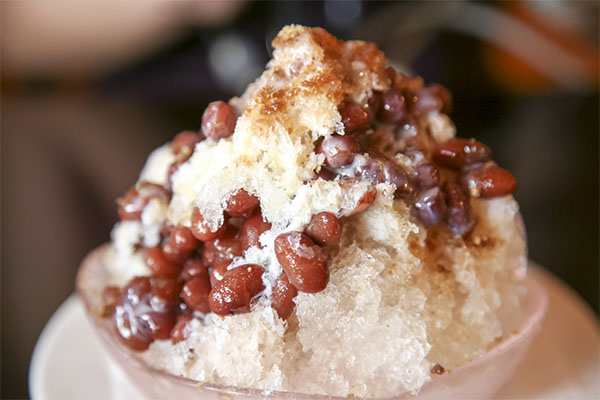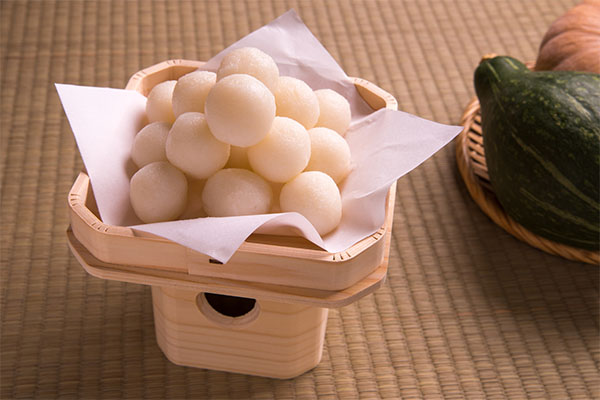INTRODUCE
Most countries have seasonal treats, but Japan is especially famous for them. That’s why many foreigners are interested in trying Japanese treats for each season.多くの国に季節のお菓子がありますが、日本のお菓子は特に有名です。そのことから、多くの外国人が、日本の季節のお菓子に興味を持っています。

PRESENT
STEP A VOCABULARY
I. Listen and repeat.聴いて、リピートしましょう。

come out発売される |

appear世に出る |

return帰る・戻る |

seasonal季節の |

limited-edition限定品 |

[thing]-flavored[物]味 |
II. Which of the phrases above can you use to talk about the foods below? Choose one or two phrases for each food.上記のフレーズのうち、下の食べ物について話す時に使うものはどれですか?1つか2つずつ選びましょう。

daifuku

shaved ice

kashiwa mochi
III. Practice reading the words.単語を読む練習をしましょう。
 /ʃ/ |
 /tʃ/ |
|---|---|
edition 版 |
suggestion 提案 |
nation 国民 |
question 質問 |
information 情報 |
indigestion 消化不良 |
STEP B GRAMMAR TIP
Use every to say how often something happens.
everyを使って、物事が起きる頻度を表すことができます。-
You can use every with durations of time, names of months, and seasons.
everyと一緒に時間や月、季節を使って、「~毎」、「毎~」と表すことができます。every
[number] weeks / months / years
week / month / year
January / February / March
winter / spring / summer / fall
-
- New flavors come out every two weeks.
- 新しいフレーバーは2週間毎に発売されます。
- I eat osechi every year.
- 私は毎年お節料理を食べます。
- You can buy ehomaki every February.
- 毎年2月には恵方巻きを買えます。
- Sakura-flavored treats appear every spring.
- 毎年春には、桜味のお菓子が発売されます。
-
You can also add once, twice, or [number] times before every to explain how many times something happens in a period of time.
every の前にonce、 twice、 [数]timesを使って、その期間に何回の頻度で起きているかを表すことができます。once / twice /
[number] times
every
[number] weeks / months / years
week / month / year
January / February / March
winter / spring / summer / fall
-
- The menu changes once every two months.
- メニューは2ヶ月に一度変わります。
- I go out to eat twice every month.
- 私は毎月2回、外食します。
- We go to the beach three times every July.
- 私たちは毎年7月には3回、ビーチに行きます。
- A limited-edition version comes out four times every year.
- 限定品は毎年4回、発売されます。
UNDERSTAND
SPEAKING
Daiki, Yuki, Eric, and Miho are having a hanami.
ダイキ、ユキ、エリック、ミホは花見をしています。
 |
- Daiki:
Eric, are you sure you’re okay?
- Eric:
I’m okay. Don’t worry! (sneezes) Sorry about that! Uh, by the way, I brought a special treat for everyone! It’s the limited-edition sakura mochi that appears every spring. I also got strawberry-flavored mochi for you, Miho. I know it’s your favorite. (sneezes)
- Miho:
Oh, wow, that’s hard to find!
- Eric:
Yeah. The traditional sweet shop near my apartment makes different types of mochi once every two weeks, but they always run out of strawberry-flavored mochi right away. They only had a few boxes left yesterday, so I immediately bought them. (sneezes) Here, have some!
- Miho:
Um… That’s nice of you, Eric. But… I think I’m still full.
- Eric:
Oh… (sneezes) I’ll put them here. Just take some from the box when you get hungry.
- Daiki:
(whispers to Yuki) Poor Eric.
TRIVIA
In English, kawaisou (可哀想) means pathetic or pitiful, but these words can sound very strong. To show sympathy, native speakers usually say poor [name].
「可哀想」は、英語で「pathetic」 または 「pitiful」と言いますが、この2つの単語はとても強い意味を持ちます。同情している時には、ネイティブスピーカーは、「poor [名前]」と言います。

PRACTICE
STEP A EXERCISE
Are the underlined parts correct? If not, correct them. Use the calendars as clues.
下線部は正しいですか?間違っている場合には、カレンダーを参考に、正しましょう。

1. Kagami mochi comes out once every year.

2. Shaved ice returns every winter.

3. A new flavor of chocolate appears four times every year.

4. That store sells a new limited-edition daifuku every winter.
STEP B EXERCISE
Make sentences with every using the pictures and words.
写真と単語をヒントにし、everyを使って文を作りましょう。

1. sweet potato-flavored treats / come out / fall

2. new parfait flavors / appear / once / two or three months

3. tsukimi dango / return / September
CHALLENGE
Challenge 1
Your foreign friend is visiting you in Japan.
外国人の友達が、日本にいるあなたを訪ねています。
Talk to him/her about seasonal treats.
友達に季節のお菓子について話しましょう。
Today's grammar tip
- every
 |
Challenge 2
Discuss your ideas. あなたの意見を言いましょう。
 If Time
If TimeAllows
1 SEASONAL DISHES |
2 FAVORITE SEASONAL TREATS |
3 FLAVORS |
|---|---|---|
|
1 SEASONAL DISHES
|
2FAVORITE SEASONAL TREATS
|
3FLAVORS
|
FEEDBACK
I can talk about Japanese seasonal treats.日本の季節のお菓子について話せるようになる。
LESSON GOAL ACHIEVEMENT
-
4
Very GoodCould complete the task with ease
-
3
GoodCould complete the task with some clarifications
-
2
FairCould complete the task with additional instructions
-
1
PoorCould somehow complete the task with difficulty
PERSONALIZED FEEDBACK
-
RANGE
表現の幅
語彙をどの程度使えるか How well can you use vocabulary? -
ACCURACY
正確さ
文法が正しく使えているかどうか Are you using grammar correctly? -
FLUENCY
流暢さ
円滑に喋ることができるかどうか Are you able to speak smoothly?

